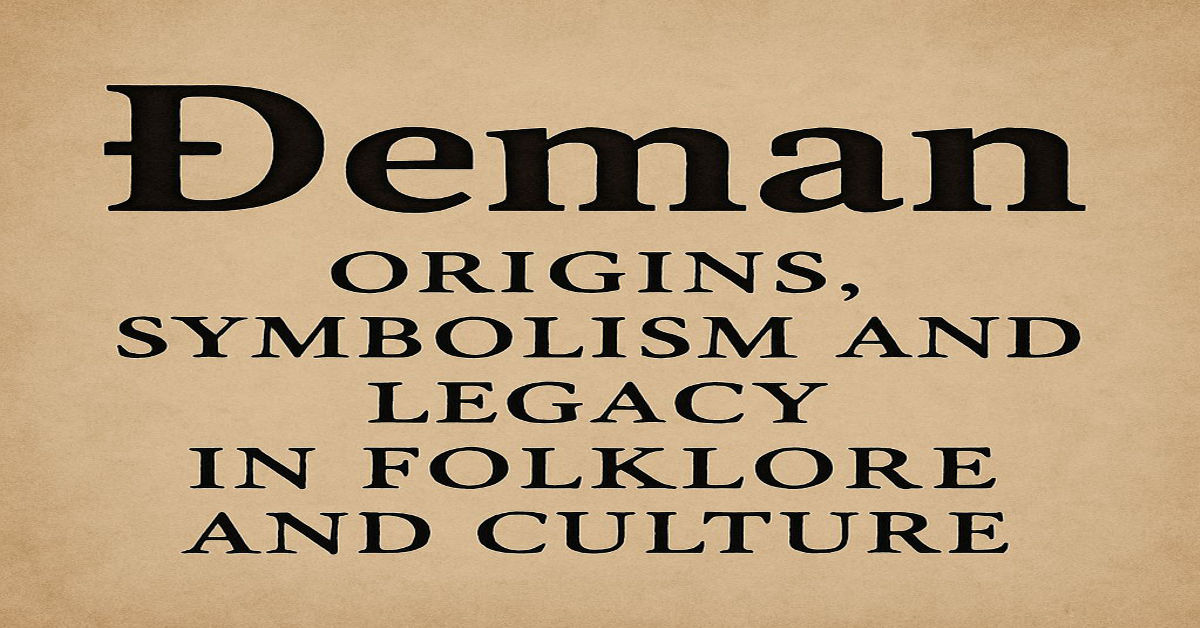The term Đeman often carries an air of mystery. While commonly mistaken for the English word “demon,” its cultural connotations run much deeper. Rooted in the folklore of Slavic and Balkan societies, Đeman represents a rich and complex archetype. Far from being a one-dimensional villain, Đeman can embody everything from untamed natural energy to spiritual guardianship.
This article explores the layered identity of Đeman—from its linguistic origins to its evolving role in folklore and modern narratives.
Etymology and Cultural Roots
The word Đeman, depending on the region, might also appear as Džin, Đavo, or even Demon. Linguistically, it is often linked with ancient Persian, Arabic, and Slavic terms referring to spirits or supernatural entities. In some traditions, these beings were not necessarily malevolent.
In Slavic languages, for instance, Đavo was a term that gradually adopted a more sinister meaning under the influence of religious narratives. However, pre-Christian cultures often viewed these entities more ambivalently—sometimes even reverently.
Đeman in Slavic and Balkan Folklore
In Balkan folklore, Đeman appears in numerous local myths, village legends, and bedtime stories. He might be the trickster in one tale, the punisher of wrongdoers in another, or even a protector in certain situations. His shape-shifting ability and moral ambiguity made him a recurring figure in pre-modern storytelling.
Villagers in mountainous regions would often warn children not to wander at night, lest they encounter the Đeman guarding the forests or the caves. He was feared, yes—but also respected.
Symbolism of Đeman Across Traditions
The symbolism of Đeman varies drastically depending on the context. In some tales, he is the representation of chaos and nature—wild, raw, and untamed. In others, he acts as a shadow self, reflecting the darker instincts and fears buried within the human psyche.
Key symbolic interpretations of Đeman include:
- Protector of nature
- Punisher of hubris
- Shadow self or inner demon
- Bridge between the human and metaphysical worlds
This diversity in symbolism highlights Đeman’s adaptability as a cultural figure.
Misunderstood Figures: From Evil to Elemental Forces
Though often aligned with demonic or malevolent forces, Đeman was not always evil. Ancient stories sometimes depicted him as misunderstood or wrongly accused of wrongdoing. This reflects broader human fears of the unknown.
In some traditions, Đeman protected sacred spaces. His anger, when provoked, was not unlike natural disasters—a storm, an avalanche, or a forest fire. Thus, Đeman became a personification of nature’s power.
The Role of Đeman in Oral Storytelling
Oral storytelling has played a significant role in preserving the character of Đeman. Through generations, tales were passed down from elders to children, often with moral or cautionary undertones. Unlike the Western concept of a singular devil, Đeman could be many things: a challenge to overcome, a lesson to learn, or a mirror to human flaws.
In regions where written texts were rare, these stories helped shape the collective understanding of right, wrong, fear, and reverence.
Modern Interpretations of Đeman
Today, Đeman is making a resurgence in literature, film, and digital media. Authors and creators reinterpret him through the lens of modern psychology, sociology, and even environmental awareness. Rather than portraying him as purely evil, he now often appears as a symbol of misunderstood energy or as a metaphysical guardian.
This modern shift reflects a broader cultural trend—moving away from black-and-white morality and embracing complexity.
Comparative Analysis: Đeman vs. Demon
While Đeman and demon may seem interchangeable, the comparison reveals distinct differences. The Western concept of a demon, especially within Abrahamic religions, is often rooted in eternal malevolence. Đeman, however, reflects duality. He can be both destructive and wise, punishing and protecting.
| Element | Đeman (Slavic/Balkan) | Demon (Western) |
| Origin | Slavic, Persian, Balkan | Abrahamic traditions |
| Morality | Dual or ambiguous | Purely malevolent |
| Role in Mythology | Trickster, protector | Tempter, tormentor |
| Symbolism | Nature, power, fear | Evil, punishment |
| Modern Usage | Reinterpreted often | Fixed traditional role |
Cultural Representations in Literature and Art
Historical texts and regional literature often personify Đeman in symbolic forms. In Serbian epic poetry, for example, he sometimes appears as a powerful adversary who tests the hero’s resolve. Artists and illustrators of the 19th and early 20th centuries depicted him in ways that reflect local fears and beliefs—horned, winged, or shrouded in mist.
Contemporary artists are now revisiting the image of Đeman, exploring his symbolic relevance in the digital age.
The Psychological and Archetypal Significance
From a Jungian perspective, Đeman could be interpreted as an archetype—the “Shadow.” This represents the unconscious, the repressed, the unknown parts of the self. Encountering Đeman in stories may symbolize a journey into the depths of one’s own psyche.
This psychological lens makes Đeman especially compelling for modern audiences seeking deeper meaning in ancient symbols.
Contemporary Relevance and Media Usage
In modern Balkan pop culture, Đeman is referenced in movies, music, and web content. These appearances range from horror-themed shows to metaphorical representations in poetry and spoken word.
He is also featured in video games and graphic novels, often as a character who challenges moral certainties and forces protagonists to question their beliefs.
Real-World Examples and Community Beliefs
In rural parts of Bosnia, Serbia, and Montenegro, belief in Đeman still exists in some form. Locals share tales of strange lights in the forest, eerie sounds in the hills, or dreams involving a shadowy figure. These stories continue to shape local rituals, such as offerings near ancient trees or rock formations believed to be Đeman’s dwelling places.
Community festivals sometimes include reenactments or storytelling circles that honor the oral tradition around Đeman.
Variants of Đeman Across Cultures
| Name Variant | Region | Description |
| Đavo | Serbia | Traditional term often aligned with evil |
| Džin | Bosnia | Spirit-like being, often elemental |
| Demon | Western influence | More malicious and fixed in evil role |
| Chort | Russia | Demon-like figure from Russian folklore |
| Poganin | Croatia | Pagan spirit, not necessarily evil |
Conclusion
Đeman is far more than a simple stand-in for the Western concept of a demon. He is a figure deeply rooted in cultural memory, mythological imagination, and spiritual symbolism. Whether as a protector, punisher, or mirror of our inner world, Đeman challenges us to look beyond surface meanings.
His journey through centuries of storytelling shows how myth and identity evolve together. As we reinterpret ancient symbols for modern lives, Đema’n remains a fascinating figure—a shadow not to fear, but to understand.
FAQs
What is the origin of the term Đema’n?
Đema’n likely derives from a mixture of Slavic, Persian, and Arabic linguistic roots. It evolved through oral traditions in Balkan and Slavic cultures.
Is Đema’n the same as a demon?
Not exactly. While similar in phonetics, Đema’n carries more nuanced meanings and is not always malevolent.
Is belief in Đema’n still prevalent?
In some rural regions of the Balkans, elements of belief persist, often blended with modern spirituality or folklore.
How is Đema’n viewed in modern media?
Modern creators often reimagine Đema’n as a misunderstood entity, protector, or psychological metaphor.
Can Đema’n be a positive figure?
Yes. Depending on the story, Đema’n might protect sacred spaces, test human character, or even serve as a guide through transformation.







